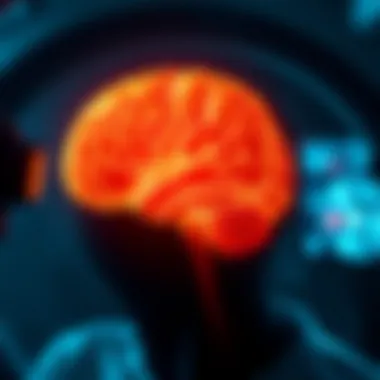Hyperbaric Chambers in Concussion Treatment: Insights


Intro
Concussions, often the result of sports injuries or accidents, have become a hot topic in medical discussions. With increasing awareness, professionals seek effective treatments for brain injuries. One treatment approach garnering attention is hyperbaric oxygen therapy (HBOT). This method, primarily known for aiding in wound healing, is now being explored as a potential remedy for concussion symptoms. Understandably, the merging of hyperbaric medicine with concussion management raises questions and intrigue in both medical communities and among enthusiasts.
By providing a platform for increased oxygen availability, hyperbaric chambers may help repair damaged brain tissue and reduce inflammation. As the scientific community investigates this connection, it is essential to unpack the underlying principles and review current research trends. In this article, we will dig into the mechanisms behind HBOT, assess recent findings, and contemplate the future of hyperbaric treatment in concussion protocols. Let's plunge into the details of how this innovative approach could reshape the landscape of concussion care.
Prologue to Concussions
Concussions have gained significant attention in recent years, not just in sports, but across various sectors of society. Understanding what constitutes a concussion is crucial, as it provides the foundation for exploring emerging treatments, such as hyperbaric therapy. In a world where head injuries can no longer be brushed under the rug, it becomes ever more pertinent to grasp concussions' implications and treatment options.
Definition and Types of Concussions
A concussion is not merely a bump on the head; it's a complex brain injury caused by a sudden jolt or blow to the head. This injury can disrupt normal brain function and lead to a wide array of symptoms. The term "concussion" can encompass various types—from mild concussions, where symptoms are fleeting, to severe instances that may include prolonged unconsciousness.
Often categorized based on severity, symptoms may also vary significantly. Examples include:
- Mild Concussion: Typically results in light headaches or temporary confusion. These symptoms may resolve within hours.
- Moderate Concussion: Leads to noticeable cognitive impairment and prolonged symptoms emphasizing the need for medical attention.
- Severe Concussion: May result in lasting neurological dysfunction, requiring intensive medical intervention.
Understanding these distinctions is vital for any health professional dealing with concussion protocols. The subtle differences can have profound implications on treatment and recovery outcomes.
Epidemiology and Incidence Rates
The frequency of concussions is alarming. Estimates suggest that millions of concussions occur annually, with rising numbers in adolescent sports, military personnel, and even in civilian life due to accidents. According to studies, football, hockey, and soccer players represent a significant portion of this statistic. In children and teenagers, high-impact sports have been linked to a concerning rise in concussion cases, highlighting the need for awareness and preventive strategies.
A deeper understanding of these statistics is important:
- Rising Trends: The increased awareness about concussions and advances in reporting have resulted in higher recorded cases.
- Demographics: Male athletes tend to report concussions more frequently than females, but some studies suggest that females may experience symptoms more severely.
- Long-Term Consequences: The chronic effects of repeated concussions are well-documented, leading some researchers to advocate for stricter protocols in youth sports.
"A single concussion may disrupt daily life, while multiple injuries can lead to long-term cognitive decline and neurological disorders."
In summary, understanding concussions—from their definitions and types to their prevalence and trend data—establishes a strong groundwork for examining innovative treatments like hyperbaric therapy. In an era where brain health is paramount, this information is not just useful; it is essential.
Understanding Hyperbaric Chambers
The importance of understanding hyperbaric chambers cannot be overstated in the realm of concussion treatment. As healthcare progressively seeks innovative therapies to enhance recovery, hyperbaric oxygen therapy (HBOT) has emerged as a compelling option. This treatment provides a unique environment where patients can receive higher-than-normal oxygen levels while under increased atmospheric pressure. Delving into how these chambers operate, and their physiological implications is critical for professionals looking to integrate them into concussion protocols effectively.
One key aspect of hyperbaric chambers is their ability to modulate the body's response to injury. When a patient enters a hyperbaric chamber, the surrounding pressure increases, allowing oxygen to dissolve into the plasma and reach areas that may be otherwise deprived in typical circumstances. This expanded oxygen availability can bestow significant benefits on the healing process, particularly in recovering from brain injuries like concussions.
Principles of Hyperbaric Oxygen Therapy
Hyperbaric oxygen therapy operates on a few foundational principles.
- Increased Pressure: The substantial atmospheric pressure within the chamber amplifies oxygen absorption into the bloodstream. This principle is based on Henry’s law, which states that gas dissolves more readily in liquids under increased pressure.
- Oxygen Dissolution: Unlike conventional oxygen delivery methods that rely solely on hemoglobin in red blood cells, HBOT permits oxygen to dissolve directly into plasma. This means that tissues can receive oxygen even when blood flow is compromised.
- Therapeutic Levels: The therapy often employs pressures greater than 1.5 ATA (atmospheres absolute), which is instrumental for conditions such as decompression sickness and carbon monoxide poisoning, besides concussions.
The principles highlighted underscore HBOT’s potential for neuroprotection by enhancing cerebral oxygenation when brain tissues are compromised.
Physical and Physiological Effects
There are several physical and physiological effects of hyperbaric therapy that may be especially relevant for concussion recovery:
- Neuroprotection: The elevated oxygen levels can help protect against apoptosis (cell death) in neurons, which can occur post-injury.
- Reduced Inflammation: As concussion often leads to inflammatory responses, HBOT may assist in reducing edema and inflammation, restoring normal cellular function.
- Enhanced Metabolism: Increased oxygen availability can stimulate gliosis and support the metabolic processes essential for effective brain recovery.
- Regeneration of Tissue: The formation of new blood vessels, known as angiogenesis, can be encouraged in the hypoxic brain regions, providing a route for recovery that may have been hindered post-injury.
These physiological effects are critical when one considers the urgency of treating concussions effectively. While concerns about treatment costs and accessibility loom large, the potential benefits of hyperbaric therapy are garnering interest, making it a worthy subject of investigation for both immediate and long-term recuperation.
For further reading on the physiological effects of HBOT and its implications in brain treatment, one can consult Wikipedia and other reputable sources like Britannica.
Mechanisms of Action in Brain Recovery
Understanding how hyperbaric therapy influences the recovery of brain function after a concussion is crucial. The mechanisms behind this treatment can reveal not just how it alleviates symptoms, but also its potential for promoting long-term recovery. Each element plays a role in ensuring that the healing process is optimized, which is particularly necessary for individuals struggling with cognitive impairments or other concussion-related issues. This section highlights three primary mechanisms—oxygenation and neuroprotection, inflammation reduction, and stimulating angiogenesis—each contributing distinctively to brain recovery.
Oxygenation and Neuroprotection
One of the cornerstones of hyperbaric treatment revolves around enhanced oxygen delivery to brain tissues. When an individual enters a hyperbaric chamber, the increase in pressure facilitates the absorption of oxygen into the bloodstream. This greater availability of oxygen is essential since brain tissue requires a consistent supply to function optimally and to recover from injuries.


Chronic hypoxia, or insufficient oxygen, can exacerbate neuronal damage after a concussion. Thus, the neuroprotective properties afforded by hyperbaric therapy can be vital. It helps in:
- Preventing further neuronal loss: Improved oxygenation can help protect brain cells from additional injury, allowing them sufficient time to repair.
- Enhancing energy metabolism: Oxygen plays a role in ATP production, the energy currency of cells. Therefore, better oxygenation bolsters the energy levels needed for recovery processes.
- Supporting neurotransmitter balance: Oxygen levels can also influence neurotransmitter release, which is fundamental in maintaining cognitive function and mood regulation.
Ultimately, the interplay between oxygenation and neuroprotection signifies why hyperbaric therapy can be a game changer in the aftermath of a concussion.
Inflammation Reduction
Concussions can lead to an inflammatory response in the brain, which may worsen symptoms and prolong recovery. Hyperbaric oxygen therapy stands out by significantly mitigating these inflammatory reactions. Increased oxygen levels reduce oxidative stress and lower levels of inflammatory markers in the brain. Specifically, the process involves:
- Decreasing edema: By reducing inflammation, hyperbaric therapy helps in managing swelling that can contribute to further injury.
- Shifting inflammatory response: It may transform a pro-inflammatory profile into an anti-inflammatory one, enabling healing rather than exacerbating damage.
- Protecting the blood-brain barrier: Oxygen helps maintain the integrity of the blood-brain barrier, an essential defense that protects the brain from harmful elements and immune responses.
By addressing inflammation, hyperbaric therapy not only aids in symptom relief but also provides a more favorable environment for cognitive recovery.
Stimulating Angiogenesis
The formation of new blood vessels, or angiogenesis, is another critical aspect of recovery from brain injuries. A concussion can compromise local blood flow, which is essential for delivering nutrients and removing waste products. Hyperbaric treatment can stimulate angiogenesis through elevated oxygen levels, producing effects like:
- Enhancing perfusion in affected areas: Increased blood flow improves nutrient delivery and waste removal, thus promoting healthier tissue.
- Supporting the recruitment of stem cells: Oxygen-rich environments can mobilize stem cells, which can give rise to neurons and supporting cells necessary for recovery.
- Encouraging neuronal repair and regeneration: New blood vessels create pathways for repair, pushing forward the healing process.
This combination of factors makes angiogenesis a focal point for maximizing the effectiveness of hyperbaric treatment in concussion management.
In summary, the mechanisms of action of hyperbaric therapy demonstrate its multifaceted approach to promoting brain recovery. By enhancing oxygenation, reducing inflammation, and stimulating angiogenesis, it addresses many underlying issues consequent to concussions, providing a holistic strategy for recovery.
In summary, the mechanisms of action of hyperbaric therapy demonstrate its multifaceted approach to promoting brain recovery. By enhancing oxygenation, reducing inflammation, and stimulating angiogenesis, it addresses many underlying issues consequent to concussions, providing a holistic strategy for recovery.
Concussion Symptoms and Hyperbaric Therapy
Understanding the interplay between concussion symptoms and hyperbaric therapy is central to improving treatment outcomes for individuals experiencing these brain injuries. Concussions often elicit a cornucopia of symptoms, ranging from headaches to cognitive impairments. As such, effectively assessing and addressing these symptoms can facilitate better recovery. Hyperbaric Oxygen Therapy (HBOT) presents a unique therapeutic option that may address not only the physical but also the cognitive repercussions of concussions.
Assessment of Concussion Symptoms
In assessing concussion symptoms, healthcare professionals utilize various methods. Traditional assessments often focus on immediate symptoms like dizziness, confusion, or balance issues. However, ongoing evaluation is crucial as the effects of a concussion can linger long after the initial injury.
Incorporating standardized assessment tools, such as the Sport Concussion Assessment Tool (SCAT) or the ImPACT test, can provide comprehensive evaluations of cognitive function and symptom severity.
"The efficacy of any treatment begins with the understanding of the problem itself."
"The efficacy of any treatment begins with the understanding of the problem itself."
Additionally, patient interviews help in gaining insight into persistent symptoms. The variability in individual responses underscores the necessity for personalized care protocols. Ultimately, a thorough assessment sets the stage for implementing hyperbaric therapy, tailoring it to specific symptomatology, and improving overall outcomes.
Impact on Cognitive Function
Cognitive function is often hit hard during and after a concussion. Many individuals report difficulties in concentrating, memory lapses, and even mood swings. These cognitive impairments stem from neurological damage and inflammation triggered by the injury.
Hyperbaric therapy aims to reverse some of these effects through enhanced oxygen delivery to the brain. By providing a hyperoxic environment, HBOT promotes cellular repair and may stimulate neurogenesis. Preliminary studies suggest that patients receiving HBOT demonstrate improvements in cognitive assessments compared to those who do not use hyperbaric treatment.
The cognitive recovery may be gradual, but the implications are noteworthy. Patients often experience a return to normal activities quicker than they would through traditional methods alone. Thus, incorporating hyperbaric therapy could be a game-changer for those battling the cognitive ramifications of concussions.
Potential Benefits of Hyperbaric Therapy
While still under investigation, the potential benefits of hyperbaric therapy in treating concussion symptoms are compelling. Some of the notable benefits include:
- Enhanced Neuroprotection: HBOT is believed to protect against further neuronal cell death during recovery.
- Reduced Inflammation: By mitigating inflammation, hyperbaric therapy can address some of the most debilitating symptoms associated with concussions, paving a smoother recovery pathway.
- Accelerated Healing: As oxygen plays a crucial role in tissue repair, facilitating greater oxygen delivery via HBOT can expedite healing processes.
- Cognitive Improvement: Anecdotal and emerging data point toward marked improvements in cognitive functions following HBOT.
In summary, while the integration of hyperbaric therapy in concussion treatment protocols is still finding its footing, the compelling evidence for its benefits warrants attention. As research develops, this innovative approach may redefine our understanding of concussion recovery, offering hope for more effective management and outcomes.
Clinical Evidence and Research Studies
Clinical evidence serves as a cornerstone in understanding the efficacy of hyperbaric therapy for concussion management. Investigating relevant studies helps illuminate the potential benefits and challenges associated with integrating this treatment into existing concussion protocols. Relying on research findings provides a framework from which clinicians can assess the validity of hyperbaric oxygen therapy (HBOT) in practical applications, ultimately ensuring treatments are evidence-based and patient-centered.
Review of Relevant Clinical Trials
When it comes to hyperbaric oxygen therapy for concussions, several clinical trials have been conducted to illuminate its potential impact. These trials delve into the physiological underpinnings and acute benefits of HBOT in brain injury recovery.
For instance, trials have typically focused on measuring cognitive recovery time and symptom alleviation among subjects. In one pivotal study, patients exposed to hyperbaric chambers showed marked improvement in post-concussive symptoms, such as headaches, dizziness, and memory issues, compared to control groups receiving standard care. Here are some notable elements found in various trials:
- Enhanced Recovery: Some studies demonstrated statistically significant decreases in recovery times for patients treated in hyperbaric environments versus those who were not.
- Neurocognitive Tests: Several clinical trials utilized neuropsychological assessments, showing improvements not just in subjective symptoms but in cognitive function scores.
- Follow-up Results: Longitudinal studies indicated that the benefits of HBOT might continue to evolve, with some subjects reporting prolonged symptom relief weeks or even months after their treatment sessions had concluded.


These findings are pivotal in assessing how hyperbaric treatment can play a role in particular recovery protocols and highlight the need for further rigorous exploration in diverse populations.
Meta-Analyses and Systematic Reviews
While individual trials shed light on certain aspects, meta-analyses and systematic reviews consolidate findings from many studies to provide a broader perspective on hyperbaric therapy’s effectiveness for concussions. These reviews integrate various data points—both qualitative and quantitative—offering a clearer picture of the collective evidence surrounding the treatment.
For example, systematic reviews have analyzed multiple clinical trials related to hyperbaric treatment and concluded that:
- Overall Efficacy: A review found that a majority of the studies support the use of HBOT for mitigating concussive symptoms, positioning it as a legitimate option in the clinician’s toolkit.
- Identification of Gaps: Many systematic reviews have pinpointed demographic or methodological gaps in the existing research, emphasizing the need for more diverse and comprehensive study populations.
- Recommendations for Future Research: Reviews not only summarize current evidence but also outline priorities for future studies. This includes the necessity for multi-center trials, larger sample sizes, and longer follow-up durations to fully understand HBOT's long-term effects on brain health.
By synthesizing the findings of numerous studies, these meta-analyses provide a compelling case for hyperbaric therapy as a promising intervention. They also help shape the dialogue surrounding concussion care and underscore the importance of continual exploration into novel treatment methodologies.
"Clinical evidence is not just a collection of data points; it is a narrative that guides the future of treatment in meaningful ways."
"Clinical evidence is not just a collection of data points; it is a narrative that guides the future of treatment in meaningful ways."
In essence, dives into clinical trials and comprehensive analyses serve to fortify the body of evidence supporting hyperbaric therapy in the context of concussion management, setting a foundation for future research and treatment protocols.
Implementing Hyperbaric Therapy in Concussion Protocols
The integration of hyperbaric therapy within concussion treatment frameworks represents a significant shift in how practitioners approach this complex injury. Concussions are not like a regular bump on the head; they can lead to a host of symptoms affecting cognitive function, emotional stability, and physical health. By implementing hyperbaric oxygen therapy (HBOT), there’s potential to enhance the management of concussions through targeted oxygen delivery that may accelerate healing processes in the brain. This section discusses key components crucial for initiating HBOT in treatment protocols, focusing on clinical relevance, benefits, and important considerations for practitioners.
Protocols for Treatment Administration
Administering hyperbaric therapy is not simply a matter of placing a patient in a chamber; it requires specific protocols that maximize safety and efficacy. The treatment typically involves sessions where patients breathe pure oxygen while exposed to increased atmospheric pressure. Protocol details can vary, but foundational considerations include:
- Session Duration: Typical treatments last around 60 to 90 minutes, but this can depend on individual conditions and responses.
- Pressure Levels: The standard pressure for concussion therapy is often set at 1.5 to 2.0 ATA (atmospheres absolute), allowing for optimal oxygen absorption.
- Number of Treatments: Research suggests a series of treatments, ranging from 10 to 40, is often necessary to gauge effectiveness and deepen neuroprotection.
It is crucial to closely monitor patients during sessions for any side effects. This ensures that therapy is customized according to each individual’s response, thus enhancing both patient safety and treatment outcomes. Documentation of each session, including patient feedback and any observable improvements, plays a vital role in refining these protocols over time.
Integrating with Other Treatment Modalities
Though hyperbaric therapy shows promise, it should not operate in a vacuum. Collaboration with other therapeutic approaches can potentiate the benefits of HBOT, creating a more comprehensive care experience. Here’s how integration can be approached:
- Physical Rehabilitation: Coupling HBOT with physical therapy can aid in improving balance and coordination, which are often compromised after a concussion.
- Cognitive Therapy: Engaging patients in cognitive exercises during or after hyperbaric treatments can support brain recovery by kickstarting cognitive functions that may have been impacted.
- Psychological Support: Adding psychological counseling can address persistent symptoms such as anxiety or mood disorders, often a hidden consequence of concussions.
Such an interdisciplinary approach allows for a holistic treatment plan, ensuring that all facets of recovery are accounted for, rather than solely focusing on the physical symptoms. It’s important for healthcare providers to maintain open communication across disciplines to effectively tailor treatment plans that respond to the evolving needs of their patients.
In summary, integrating hyperbaric therapy into concussion protocols not only enhances the likelihood of successful recovery but also personalizes treatment by addressing individual patient needs. This comprehensive approach underscores the value of considering a spectrum of therapeutic options, ensuring that the path to recovery is as smooth as possible for those affected by concussions.
In summary, integrating hyperbaric therapy into concussion protocols not only enhances the likelihood of successful recovery but also personalizes treatment by addressing individual patient needs. This comprehensive approach underscores the value of considering a spectrum of therapeutic options, ensuring that the path to recovery is as smooth as possible for those affected by concussions.
Challenges and Limitations
In discussing the role of hyperbaric chambers in the treatment of concussions, it is imperative to consider the challenges and limitations that come with such a therapeutic approach. While hyperbaric oxygen therapy (HBOT) has shown promise in various clinical settings, offering potential benefits in terms of brain recovery and symptom relief, it is not without its hurdles. This section aims to shed light on critical elements, weighing the advantages against the broader concerns surrounding accessibility, cost, and safety.
Cost and Accessibility of Treatment
When evaluating hyperbaric therapy, one of the most significant barriers observed is the cost associated with treatment. Different facilities have varied pricing structures, but a single session can set a person back several hundred dollars, sometimes requiring multiple sessions for substantial effect.
Moreover, not all insurance providers cover hyperbaric treatments, primarily if they are viewed as experimental for concussion recovery. This can leave patients in a tight spot, caught between wanting to utilize progressive treatment options and facing financial limitations.
- Variability in Costs:
- Prices can range from $200 to $1,000 per session depending on location, facility, and specific therapy protocols.
- Package deals may be available, but upfront costs can still be daunting.
Additionally, geographical access to hyperbaric chambers can pose a significant issue. Many hospitals and private practices offering HBOT are concentrated in urban areas, leaving individuals in rural regions without easy access. This uneven distribution magnifies existing healthcare disparities.
- Accessibility Concerns:
- Patients in remote areas might need to travel long distances, which can be costly and time-consuming.
- Limited local awareness or availability of HBOT specialists can hinder timely intervention.
Risks and Contraindications


Every medical treatment has its risks, and hyperbaric oxygen therapy is no exception. While generally considered safe for many, specific factors can render it unsuitable for certain individuals. Understanding these contraindications is essential for healthcare providers and patients alike, as it shapes the decision-making process regarding treatment.
Some of the risks involved in HBOT include:
- Barotrauma: An injury caused by changes in pressure, affecting the lungs and ears, particularly in patients with underlying respiratory problems.
- Oxygen Toxicity: At elevated pressures, excessive oxygen can lead to neurological or pulmonary complications.
- Claustrophobia: For some patients, the enclosed environment of a hyperbaric chamber can induce anxiety or panic attacks.
Furthermore, specific medical conditions act as contraindications to HBOT. For example:
- Patients with severe chronic obstructive pulmonary disease (COPD) may face complications.
- Those with untreated pneumothorax or certain types of cancer should approach hyperbaric therapy with caution.
It's critical to conduct comprehensive evaluations before recommending hyperbaric therapy. Individual health histories must guide clinical decisions, ensuring that potential benefits outweigh any associated risks.
It's critical to conduct comprehensive evaluations before recommending hyperbaric therapy. Individual health histories must guide clinical decisions, ensuring that potential benefits outweigh any associated risks.
In summary, while hyperbaric chambers present exciting avenues for concussion treatment, careful consideration around cost, accessibility, and patient safety is crucial to navigate the path forward in this developing field. Balancing these challenges with the potential benefits will be essential to harnessing the full capabilities of hyperbaric therapy in managing concussions.
Future Directions in Research
As we stand at the crossroads of innovative concussion treatment modalities, future directions in research will play a pivotal role in shaping our approach towards the integration of hyperbaric chambers in concussion care. Understanding how hyperbaric oxygen therapy influences recovery on a physiological level could unlock a treasure trove of therapeutic possibilities. By not only recognizing its role in immediate recovery post-concussion but also exploring its potential for long-term brain health effects, researchers can contribute to a more nuanced understanding of brain injuries.
Future research should focus on several key elements:
- Longitudinal Studies: Investigating the long-term effects of hyperbaric therapy on cognitive function and brain recovery could provide vital insight. By analyzing recovery patterns over an extended period, researchers can ascertain whether benefits are sustained or if the therapy merely mitigates acute symptoms. An example can be found in studies similar to the ones at the National Institute of Health.
- Diverse Populations: It's critical to assess how variables such as age, sex, and baseline health status influence outcomes. By including a wider demographic in studies, findings can be tailored to make hyperbaric therapy accessible to more individuals suffering from concussions.
- Synergistic Treatments: Researching combinations of hyperbaric therapy with other modalities, such as physical therapy or cognitive rehabilitation, could provide a holistic approach to concussion management. This synergistic exploration could open avenues for protocols that enhance recovery rates and promote overall neurological health.
The emergence of new studies in hyperbaric therapy signals a wave of change in concussion treatment, suggesting that we are only beginning to scratch the surface of its potential.
The emergence of new studies in hyperbaric therapy signals a wave of change in concussion treatment, suggesting that we are only beginning to scratch the surface of its potential.
Additionally, ethical considerations cannot be ignored. With any therapy, the balance between potential benefits and risks must be scrutinized. This scrutiny includes ongoing evaluations of safety, informed consent processes for patients, and exploring patient perceptions of undergoing hyperbaric therapy for concussion treatment.
Emerging Studies in Hyperbaric Therapy
The landscape of emerging studies in hyperbaric therapy has begun to shift with growing interest in its application beyond traditional uses. Several recent investigations have yielded promising results. One study conducted by researchers at Boston University demonstrated significant improvements in cognitive performance among post-concussion patients after a regimen of hyperbaric treatments.
Additional research indicates that hyperbaric therapy may reduce the onset of post-concussion syndrome, a lingering condition that affects many individuals who have experienced head trauma.
To better understand these emerging findings, it's essential to analyze:
- The Role of Oxygen: Insights into how increased oxygen availability enhances the metabolic function of brain cells could reveal mechanisms to accelerate recovery.
- Neuroinflammation: Newer evidence suggests that hyperbaric therapy could play a role in reducing inflammation within the brain following injury, a significant factor in delayed recovery.
- Patient Reports: Anecdotal feedback from patients who have undergone hyperbaric sessions frequently highlights improvements in mood and clarity, needing to be substantiated through systematic research.
While promising, these studies also unveil complexities that warrant careful consideration, including the quality of evidence, sample sizes, and methodologies employed.
Potential for Broader Applications
The potential for broader applications of hyperbaric therapy extends well beyond the realm of concussions. While its efficacy in treating acute brain injuries is garnering attention, research is expanding into several significant areas:
- Traumatic Brain Injury (TBI): A connection exists between concussion and more severe traumatic brain injuries. The evolving treatment protocols for TBIs could parallel those being developed for concussions, allowing hyperbaric therapy to become a staple in managing these injuries.
- Neurodegenerative Disorders: Diseases such as Alzheimer’s and Parkinson’s may benefit from hyperbaric therapy due to its neuroprotective effects, showcasing the treatment's versatility. Studies involving** older populations** might shine light on its preventative potentials.
- Sports Medicine: Increased awareness in sports medicine could result in hyperbaric treatment becoming a standard part of an athlete’s recovery protocol. This application is crucial considering the rising concerns about repeated concussions, especially in contact sports.
The adaptability of hyperbaric therapy could revolutionize not just treatment protocols but also shift prevailing attitudes surrounding injury management, offering hope where little existed before. Ongoing scrutiny and advancements in research will determine how far this therapy can reach into the medical landscape.
However, as with any promising innovation, a careful balance must be maintained between the excitement of potential and the rigor of scientific evaluation.
Concluding Thoughts
As we close the discussion on the intersection of hyperbaric chambers and concussion treatment, it's vital to reflect on the significance of this emerging field. The journey through understanding concussions—how they are caused, the symptoms they manifest, and their overall impact on individuals—has been a complex one. However, the potential of hyperbaric oxygen therapy to serve as a forefront treatment option brings renewed hope.
Summary of Insights
The application of hyperbaric therapy in concussion management is not merely a passing fad; it embodies a growing recognition that innovative approaches can yield meaningful benefits. By enhancing oxygen delivery to the brain and reducing inflammation, hyperbaric chambers show promise in facilitating recovery. This is especially important given that typical treatment protocols often leave patients with lingering symptoms that can severely impact their quality of life.
Some of the key insights include:
- Neuroprotection and Recovery: Hyperbaric therapy’s ability to oxygenate brain tissue may foster neuroprotection and enhance healing, addressing the complex pathology associated with concussions.
- Clinical Evidence: While research is still in its infancy, preliminary studies indicate that there may be significant benefits to utilizing hyperbaric therapy in conjunction with traditional concussion management strategies.
- Integration Challenges: Practical considerations such as cost, accessibility, and the need for further studies remain critical as healthcare providers look to integrate this therapy into standard practice.
Call for Continued Exploration
The pathway to establishing hyperbaric therapy as a staple in concussion management isn't without hurdles. Both clinicians and researchers need to collaborate further to deepen our understanding of how this treatment can be effectively utilized. Through rigorous clinical trials and thoughtful analysis, we can uncover the nuances that may enhance its application.
Furthermore, continuing dialogue among healthcare professionals, patients, and researchers is essential. We must advocate for funding and support to investigate this treatment's broader implications—not only in concussions but potentially within other areas of brain health.
"The only thing more expensive than education is ignorance." - Benjamin Franklin
"The only thing more expensive than education is ignorance." - Benjamin Franklin
Increasing investment in research on hyperbaric therapy could very well prove to be a wise decision. As exploration continues, the ultimate goal remains clear: to maximize recovery for individuals facing the reality of concussions.







